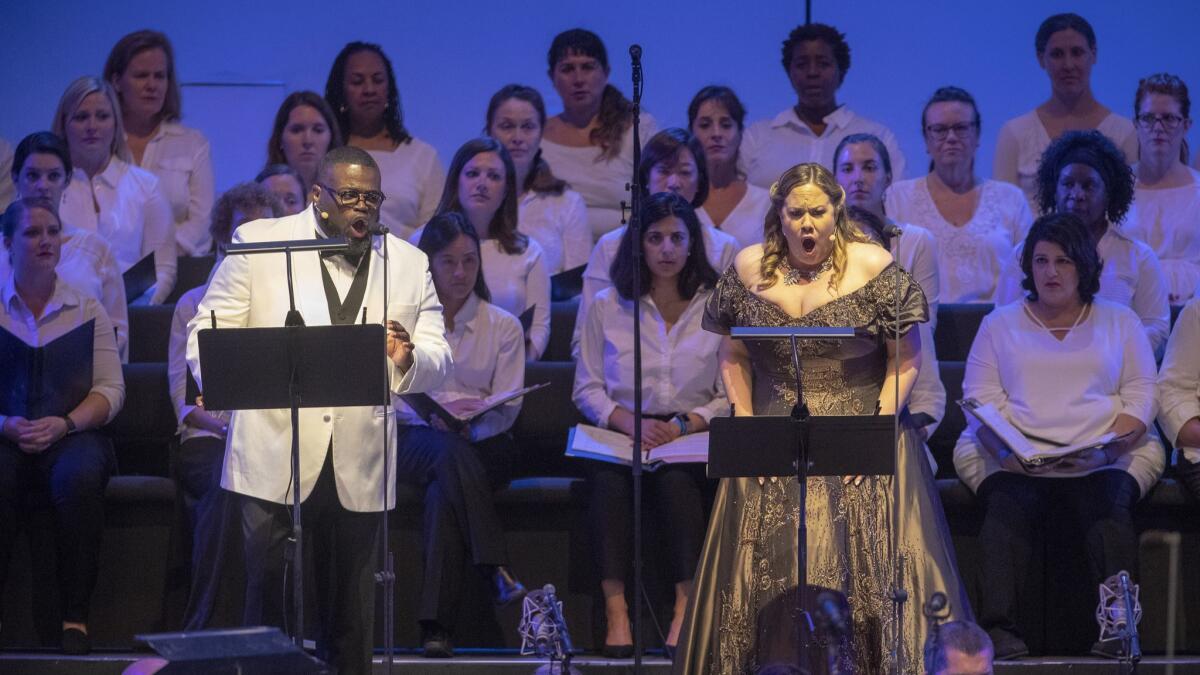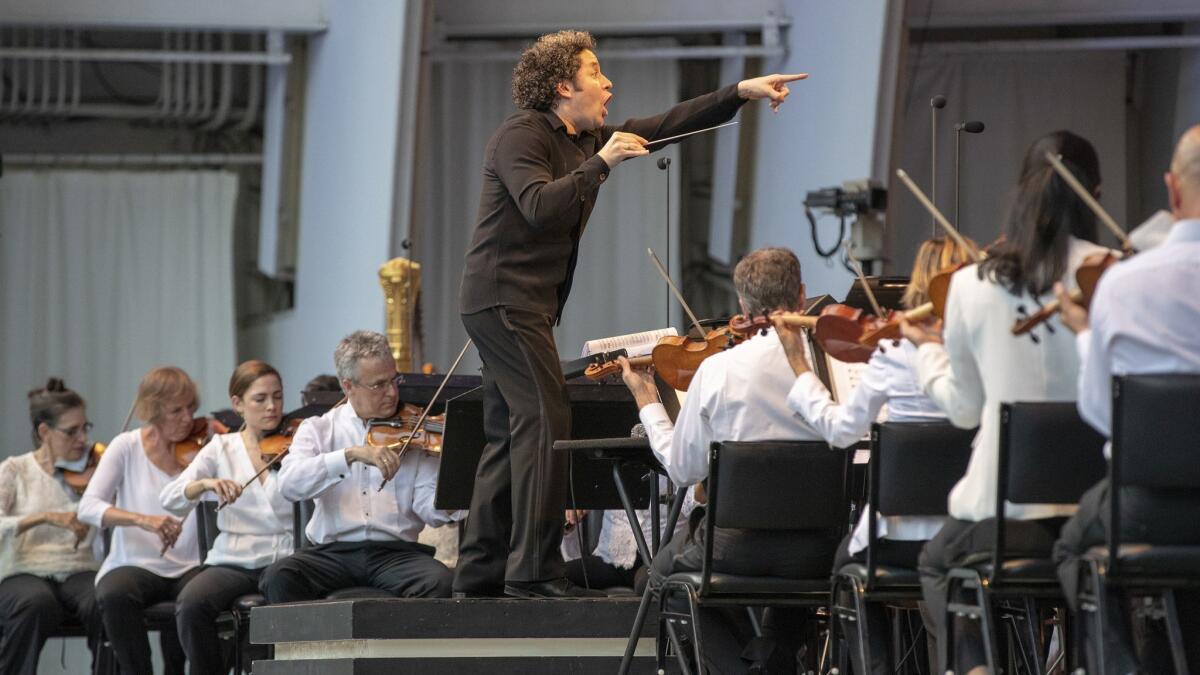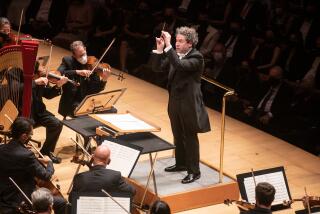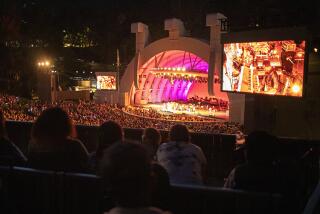Review: With pomp and power, Dudamel fits Verdi’s ‘Otello’ into the Hollywood Bowl

From its earliest days, the Hollywood Bowl has thought of itself as a Hollywood-size opera house. And why not? Opera likes all things outsize. Full summer opera seasons in the amphitheater once drew sizable crowds long before there was alfresco amplification or L.A. had a major opera company.
Gustavo Dudamel picked up on the Bowl’s operatic potential from the start, and for the past decade a reliable highlight of the Los Angeles Philharmonic’s Bowl programming has been Dudamel’s annual concert opera performances. Lusty and grand Italian opera has been his reasonable outdoor preference, with a special emphasis on Verdi and Puccini.
But Verdi’s “Otello” Sunday night brought special challenges. I don’t think any reasonable Verdian would argue with John Henken’s program notes, which describe “Otello” as “perhaps the finest of his tragedies,” other than with the “perhaps.” I would go much further. The doggedly dramatic focus of “Otello” is simply harrowing in a way no other Shakespeare adaptation can equal.
Harrowing, however, is no picnic at the Bowl, where distractions, amplification, video, aerial interruptions and lack of rehearsal time all enter into the picture. Beyond all that, “Otello” really does demand staging.
Dudamel’s solution was to stick to the basics. He took few chances with the cast, relying on singers he works with regularly. Russell Thomas and Julianna Di Giacomo, the Otello and Desdemona, starred in Dudamel’s “Tosca” at the Bowl two years ago. Di Giacomo and Jennifer Johnson Cano, Emilia (Iago’s wife), toured with Dudamel and the L.A. Phil this spring as soloists in Beethoven’s Ninth Symphony. George Gagnidze made his L.A. debut as Iago Sunday, but he has sung often with L.A. Opera
The singers focused on the score, standing on a platform behind the orchestra and in front of the chorus. They made a few well-timed entrances and exits, but mainly we watched them on the video screens and listened to them through the Bowl’s sound system, the latter of which gets upgrades every year.
That might have seemed an issue, given the heavy-handed amplification used for the orchestra’s Leonard Bernstein opening night program last week. Improved subwoofers can now supply more of the bass oomph that pop concerts welcome. There is added power overall, again to make pop happy, and tighter sonic focus to make everyone happy.
Along with power comes responsibility. The directive for Bernstein was Broadway big, so the engineers complied by mimicking that over-amplified Broadway theater sound design that gives singers a huge helping hand for knocking ‘em dead but grotesquely distorts the orchestra.
For “Otello,” the sound was sumptuous. Here the acoustical model appeared to be the analog opera recordings of the 1960s. Expansive voices ruled. The orchestra sounded richly colored and rightly detailed. Balance may not always have been perfect, given the difficulty of miking singers when they are on the move. Electronics can never be trusted 100% so there were glitches, but overall the results were highly satisfying.
The larger issue, though, is perceptual, the one of what is real and what isn’t that we are now being forced to grapple with 24/7. Not only did the performance sound like a wonderful opera recording, the Bowl shell looked to some degree like a soundstage with the singers standing at music stands in front of microphones.
There could be no real telling, for instance, about the size of voices. When Di Giacomo’s mike momentarily failed during the first act, the volume only slightly dropped. But she had the lung power and presence of mind to make up for it, an unscripted, thrilling moment.
In addition, the opera had to be perceived on different levels at once. The amplification offers one kind of immediacy. The video screens bring the far away close up but without giving you the choice of where or how to look. And then there is the actual performance, far away for some, farther away for others.
Much of the time, the singers seemed on their own theatrically, their interaction more with Dudamel and the orchestra than with each other. But Thomas gave notice that he has the making of a compelling Otello, which he will on the opera stage for the first time next year for Canadian Opera.
His tone was clarion without being imperious, more a wounded, vulnerable leader. It wasn’t Iago who poisoned him with false intimations of Desdemona’s infidelity so much as a society uncomfortable with, and condescending toward, an outsider.
Nor was Di Giacomo a meek Desdemona but an outraged one. Her intense “Willow Song” and “Ave Maria” in the last act were as sacrificial odes, far too finely focused for self-pity. Gagnidze’s Iago understated evil, acting more like a small-time operator, while Cano’s Emilia was, like Desdemona, the stronger force, further bringing out Verdi’s feminist take on Shakespeare.
Against this tide, Cassio (Paolo Fanale), Lodovico (Önay Köse), Roderigo (Derek Taylor) and Christopher Job (Montano) were pawns.
The tide was especially strong in Dudamel’s forceful, detailed, exuberant, crushingly tragic performance. For the large ensembles he created exceptional grandeur with the help of the Los Angeles Master Chorale and Los Angeles Children’s Chorus.
The intimacy may have been left up to the singers to bring the Bowl down to size, but the Dudamel-produced pomp was such that any opera house would have been too small to contain it.

More to Read
The biggest entertainment stories
Get our big stories about Hollywood, film, television, music, arts, culture and more right in your inbox as soon as they publish.
You may occasionally receive promotional content from the Los Angeles Times.







